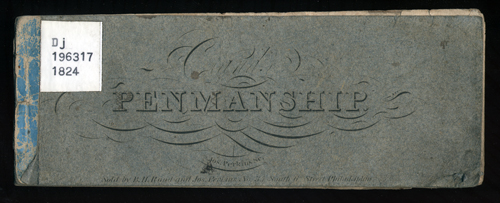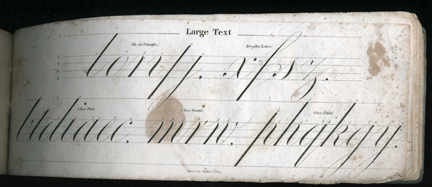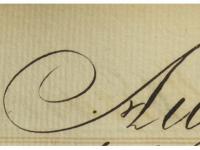They had such nice hand writing back then!
If only I had a dollar every time I’ve heard that. Yes, many scribes of our manuscripts did have a nice script. But there are plenty of writers who didn’t. My personal favorite is William Penn:

Shall I translate? This is a recipe he copied from his mother’s receipt book: “To Make Coffee” (for more about the recipe see this post.) But we cannot criticize Mr. Penn too much, after all, this copy was only intended for personal use.
Official correspondence, on the other hand, between anyone, had to be legible. All record keeping was done by hand; personal letters, business correspondence, copies of correspondence, bills, bank ledgers, orders, all of it had to be recognizable to everyone reading it.There were no telephones to verify an illegible order across the ocean, no typewriters to ensure uniform letter recognition. And even though, they make it look so easy, beautiful penmanship is not an innate skill. It was a skill to be learned, practiced and perfected. A confident legible script was vital for gainful employment.
There were several schools of thought and books students of penmanship could subscribe to. HSP’s collections hold some examples of these (printed) books including; Penmanship Explained; or The Principles of Writing Reduced to an exact Science by S.A. Potter. (Dj .1962)

According to Mr. Potter: “Writing should, in all cases, be a daily exercise. In most schools, one hour a day should be devoted to the subject of penmanship. Three-fourths of an hour should be given in a school. Many teachers consider this subject of so little importance that they let other studies of less consequence crowd it out, so that many of the boys and girls who have been under their charge, when obliged to leave school early to labor for a livelihood possess but a miserable handwriting. We look upon a cripple, made so by misfortune, with a great deal of sympathy, especially if he was wounded by a ball from the enemy. But when we see pupils sent out into the world, crippled in their handwriting for life, whom must we pity?

These books cover all the important elements of beautiful writing, including the pen and how to hold it, how to make a one, ink, paper, and posture, and of course, correct letter forms.

The workbooks include sample templates for bank deposits, bills and orders.


My favorite of these work books is the Spencerian System, (Dj .196). It is by far the most detailed in its instruction, illustrating the correct letter forms, as well as what is incorrect. Of all the books I looked at, I think I could actually teach myself from this one. 
Working on the Bank of North America Collection (1939), has reinforced our admiration for the scribes of the bank. Their writing is beautiful and consistent. Everything they wrote is still perfectly legible.


In addition to the beautiful and legible writing the scribes left us, they also left us some beautiful embellishments. We like to imagine a bored scribe with nothing more to do at hand, than practice his penmanship.


In spite of the fact that these scribes worked so hard that we might be able to read their records 200 years later, we as a society are bumping up against an issue created by the proliferation of computers, texting, etc. If you have school age students you might already be aware that some schools are no longer teaching cursive. With the loss of this skill, reading manuscripts will become a necessary occupation for someone.
In the meantime, should you wish to practice your own penmanship, visit the website of the International Association of Master Penman, Engrossers, and Teachers of Handwriting. You find many lessons, tips and tricks.


